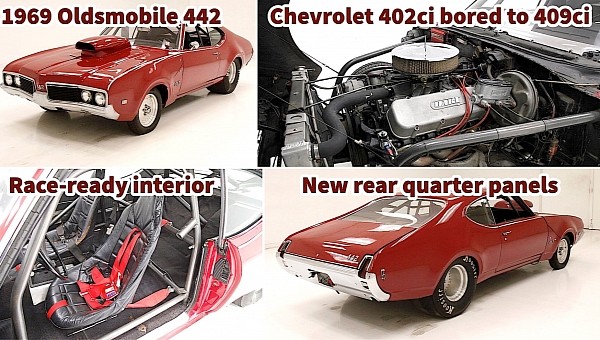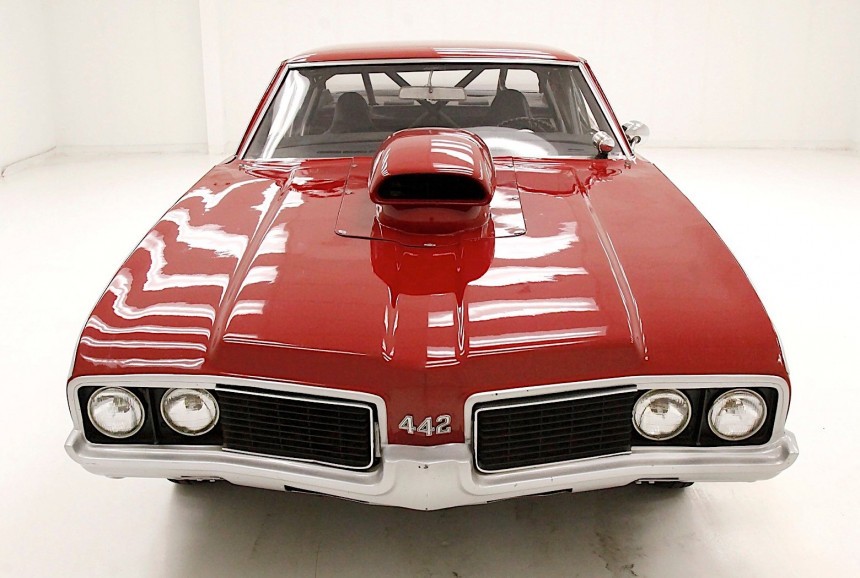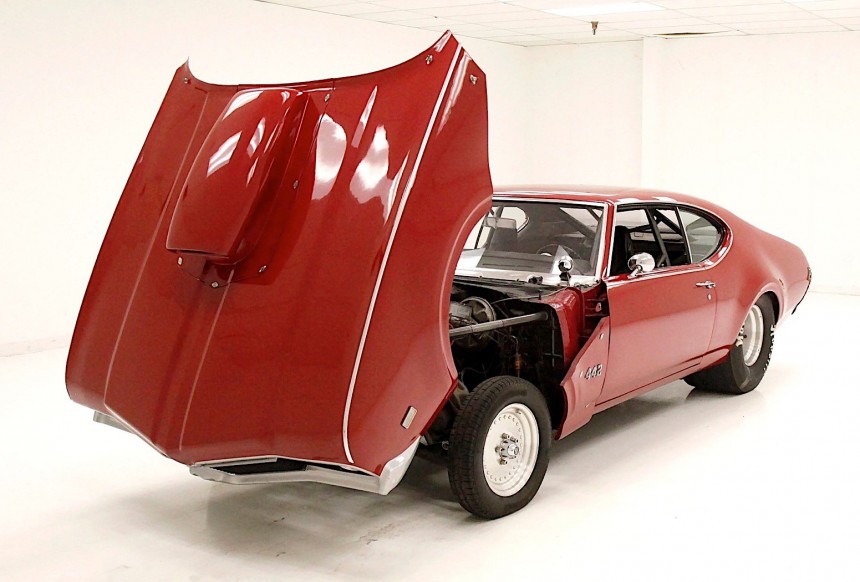All of you keeping an eye on our constant coverage of the American custom car scene know by now this industry is an unending source of mechanical wonders. But you might also have noticed how most of the time, the classic American vehicles that surface as customs often do so in show or collectible form. And that means they’re mostly just pretty faces, with no one actually driving and properly enjoying them for fear of not ruining the work.
But not this 1969 Oldsmobile 442. The iconic American muscle car initially came into this world with clear goals in mind: to be driven and raced more than admired. And it’s exactly what the example we’re here to look at today offers.
If you’re reading this, chances are you already know a thing or two about the… 442 (here, I made that rhyme). We’re talking about a type of muscle car the now defunct GM brand called Oldsmobile tried to make on three separate occasions, but gave up on it every time.
The first stint on the market of the 442 came in 1964, as the result of some infighting with GM sibling Pontiac. Back then, it was offered as an option for the Cutlass. This version was discontinued in 1980, only to be revived again five years later, also as a twisted Cutlass. It lasted only two years, and then came back again in 1990 to last for just one more.
So technically, the 442 was on the market for 27 (not continuous) years and, during that time, it came and went as six generations. The 1969 example we’re looking at now is a second-gen, meaning the one that first came separated from the Cutlass.
Like all other cars of its kind, it is called 442 (initially 4-4-2) because it originally rocked an engine with a four-barrel carburetor, tied to a four-speed manual transmission, and it had a dual exhaust. In the second generation, that engine would be either a 400ci or a 455ci, as these two were the only options offered from the factory. Not all of those elements are to be found on this custom one.
First up, the engine is no longer the one the Oldsmobile had on back in the 1960s. The front end, massive and sporting a huge scoop on the fiberglass hood, tilts completely out of the way to reveal a 402ci of Chevrolet make, but not in its stock form either. We’re told it was bored to 409ci, and we can see it still uses a 4-barrel carburetor, made by Holley.
The performance figures of the engine in this application are not known, but the unnamed builders of the track monster did tie it to a 3-speed automatic transmission and fitted a racing exhaust with the proper mufflers.
The engine sends its power to the massive rear wheels. Just like the front ones, they are of Center Line make and sized at just 15 inches in diameter, but unlike the front pair they are a lot wider and wrapped in drag slicks - yet another proof that this car was made not to be admired on a stand, but raced on the track.
The body of the 442, now draped in red, has largely remained unchanged in terms of overall shape, and it even has the factory trim around the windows. There are some differences though that make the ride look a bit more muscular, especially at the rear, where new quarter panels were installed, and in the bigger wells, enlarged to be able to support the much wider wheels.
Behind the wheels, you’ll find Wilwood braking hardware, and a suspension system comprising coil springs up front and coil overs out back. Underneath the car, new steel plating has been added to help with aero, and the original fuel tank was replaced.
Another hint this is a no show car, but a rugged beast (hence the name we chose for it), is the fact the interior looks anything but welcoming. The car’s original bucket seats were replaced with racing high backs in vinyl, fully equipped with 5-point safety belts. A roll cage wraps around both of them, allowing access inside by means of a removable angle pipe.
The dashboard still retains some of the original gauges, including the speedometer, but a bunch of others were installed all over it to cater to the driver’s racing needs (showing data on temperature, volts, and engine vacuum, among others), accompanied by extra toggles and warning lights. Somewhat unexpected from a drag racer, the 442 comes equipped with an aftermarket radio.
We stumbled upon the 1969 Oldsmobile 442 “Rugged” as it awaits a new owner to come and claim it off the lot of a Pennsylvania dealer called Classic Auto Mall. The car shows just under 10,000 miles (16,000 km) on the clock, but we’re not told how many of them have actually been recorded on the drag strip.
We also have no record of the races this 442 attended, but that isn’t stopping the seller from asking $25,500 for the thing.
If you’re reading this, chances are you already know a thing or two about the… 442 (here, I made that rhyme). We’re talking about a type of muscle car the now defunct GM brand called Oldsmobile tried to make on three separate occasions, but gave up on it every time.
The first stint on the market of the 442 came in 1964, as the result of some infighting with GM sibling Pontiac. Back then, it was offered as an option for the Cutlass. This version was discontinued in 1980, only to be revived again five years later, also as a twisted Cutlass. It lasted only two years, and then came back again in 1990 to last for just one more.
So technically, the 442 was on the market for 27 (not continuous) years and, during that time, it came and went as six generations. The 1969 example we’re looking at now is a second-gen, meaning the one that first came separated from the Cutlass.
First up, the engine is no longer the one the Oldsmobile had on back in the 1960s. The front end, massive and sporting a huge scoop on the fiberglass hood, tilts completely out of the way to reveal a 402ci of Chevrolet make, but not in its stock form either. We’re told it was bored to 409ci, and we can see it still uses a 4-barrel carburetor, made by Holley.
The performance figures of the engine in this application are not known, but the unnamed builders of the track monster did tie it to a 3-speed automatic transmission and fitted a racing exhaust with the proper mufflers.
The engine sends its power to the massive rear wheels. Just like the front ones, they are of Center Line make and sized at just 15 inches in diameter, but unlike the front pair they are a lot wider and wrapped in drag slicks - yet another proof that this car was made not to be admired on a stand, but raced on the track.
Behind the wheels, you’ll find Wilwood braking hardware, and a suspension system comprising coil springs up front and coil overs out back. Underneath the car, new steel plating has been added to help with aero, and the original fuel tank was replaced.
Another hint this is a no show car, but a rugged beast (hence the name we chose for it), is the fact the interior looks anything but welcoming. The car’s original bucket seats were replaced with racing high backs in vinyl, fully equipped with 5-point safety belts. A roll cage wraps around both of them, allowing access inside by means of a removable angle pipe.
The dashboard still retains some of the original gauges, including the speedometer, but a bunch of others were installed all over it to cater to the driver’s racing needs (showing data on temperature, volts, and engine vacuum, among others), accompanied by extra toggles and warning lights. Somewhat unexpected from a drag racer, the 442 comes equipped with an aftermarket radio.
We stumbled upon the 1969 Oldsmobile 442 “Rugged” as it awaits a new owner to come and claim it off the lot of a Pennsylvania dealer called Classic Auto Mall. The car shows just under 10,000 miles (16,000 km) on the clock, but we’re not told how many of them have actually been recorded on the drag strip.
We also have no record of the races this 442 attended, but that isn’t stopping the seller from asking $25,500 for the thing.


















